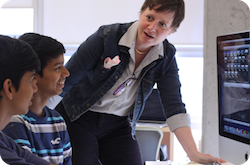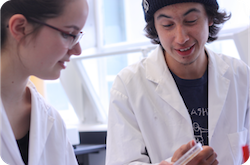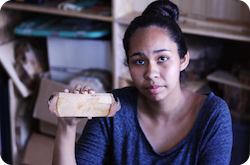PIMS Emerging Aboriginal Scholars Summer Camp
The Pacific Institute for the Mathematical Sciences (PIMS) is dedicated to increasing public awareness of the importance of mathematics and encouraging students to see mathematics as subject that opens doors to careers in many exciting fields. PIMS is also a strong advocate for Aboriginal and First Nations students and for the past four years Melania Alvarez, PIMS’ BC Education Coordinator, has worked in collaboration with UBC’s First Nations House of Learning to deliver the Emerging Aboriginal Scholars High School Summer Camp at UBC. This camp has been proudly sponsored by the UBC Mathematics Department, the Government of British Columbia, the UBC Faculty of Science, the Vancouver Foundation, as well as a number of private donors.
This five-week summer camp provides an innovative program of learning for Aboriginal students at the high school level. In addition to 90 minute classes of both math and English every morning, three afternoons each week are spent working with UBC faculty and researchers in a field of the students’ choosing. With program options ranging from engineering to microbiology to forestry to human resources, the 31 enrolled students really get an opportunity to experience the university work and research environment, shape their career aspirations and interact with some amazing teachers and mentors.
 Nakoda and Erik (twin brothers) spent their work opportunity touring a number of locations within the Electrical and Computer Engineering Department. In the Alpha Power Laboratory, they learned about power supply technology used in UBC’s smart grid, at the Robotics and Control Laboratory they saw the Da Vincci surgical robot and at the System on Chip Laboratory they saw the tools used to develop new computer chip architecture. Erik excitedly recalled some of the hands on experience they received using ultrasound machines and MRI equipment and how when they visited the circuitry lab they got to build and test their own working circuit.
Nakoda and Erik (twin brothers) spent their work opportunity touring a number of locations within the Electrical and Computer Engineering Department. In the Alpha Power Laboratory, they learned about power supply technology used in UBC’s smart grid, at the Robotics and Control Laboratory they saw the Da Vincci surgical robot and at the System on Chip Laboratory they saw the tools used to develop new computer chip architecture. Erik excitedly recalled some of the hands on experience they received using ultrasound machines and MRI equipment and how when they visited the circuitry lab they got to build and test their own working circuit.
 At the Department of Microbiology and Immunology, Matthew and Sabine worked in a lab with faculty member David Oliver. One project they worked out was on microbes; they made petri plates, sampled their surrounding environment and let the cultures grow for several weeks. "We took samples from all sorts of places like the staff fridge, my shoe, moss, the table, doorknobs..." Said Sabine, reporting that so far, the women’s washroom and the staff fridge were the grossest samples. For Matthew and Sabine, they get to enact the scientific process: making hypothesis, testing
them, and drawing conclusions from the findings. “I was interested in exploring science" says Matthew of his choice to join this cohort, "and I wanted to go more in depth than I already had."
At the Department of Microbiology and Immunology, Matthew and Sabine worked in a lab with faculty member David Oliver. One project they worked out was on microbes; they made petri plates, sampled their surrounding environment and let the cultures grow for several weeks. "We took samples from all sorts of places like the staff fridge, my shoe, moss, the table, doorknobs..." Said Sabine, reporting that so far, the women’s washroom and the staff fridge were the grossest samples. For Matthew and Sabine, they get to enact the scientific process: making hypothesis, testing
them, and drawing conclusions from the findings. “I was interested in exploring science" says Matthew of his choice to join this cohort, "and I wanted to go more in depth than I already had."
 In the Faculty of Forestry, Keisha, Ocean and Blaise worked with professor Lori Daniels’ team on a number of projects including one to detect marker tree-rings associated with the 1964 Port Alberni Tsunami study. The students scanned the tree cores and measured tree-ring widths. They also worked on a project that studied and measured aging seedlings prior to and after a prescribed burn to understand forest stand attributes as well as assisting with creating a wood "library" representing the history of forest fires in BC over many hundreds of years and with palm sanding large discs of western red cedar and Douglas-fir which will be used for education purposes by the First Nation coordinator at the Faculty of Forestry. "It has been a pleasure having Blaise, Ocean and Keisha work with us in the Tree Ring Lab. Through their internships, they have contributed to a range of research projects that are helping to make a difference in the way we conserve and manage BC`s forests" said Daniels.
In the Faculty of Forestry, Keisha, Ocean and Blaise worked with professor Lori Daniels’ team on a number of projects including one to detect marker tree-rings associated with the 1964 Port Alberni Tsunami study. The students scanned the tree cores and measured tree-ring widths. They also worked on a project that studied and measured aging seedlings prior to and after a prescribed burn to understand forest stand attributes as well as assisting with creating a wood "library" representing the history of forest fires in BC over many hundreds of years and with palm sanding large discs of western red cedar and Douglas-fir which will be used for education purposes by the First Nation coordinator at the Faculty of Forestry. "It has been a pleasure having Blaise, Ocean and Keisha work with us in the Tree Ring Lab. Through their internships, they have contributed to a range of research projects that are helping to make a difference in the way we conserve and manage BC`s forests" said Daniels.
PIMS educational programs aim to narrow the historical gaps that exist between men, women and underrepresented minorities and their interest in the mathematical sciences. We believe that providing increased opportunities and programs will challenge existing stereotypes and boost students’ interest and passion for mathematics in challenging and meaningful ways.
Tweet
This five-week summer camp provides an innovative program of learning for Aboriginal students at the high school level. In addition to 90 minute classes of both math and English every morning, three afternoons each week are spent working with UBC faculty and researchers in a field of the students’ choosing. With program options ranging from engineering to microbiology to forestry to human resources, the 31 enrolled students really get an opportunity to experience the university work and research environment, shape their career aspirations and interact with some amazing teachers and mentors.
 Nakoda and Erik (twin brothers) spent their work opportunity touring a number of locations within the Electrical and Computer Engineering Department. In the Alpha Power Laboratory, they learned about power supply technology used in UBC’s smart grid, at the Robotics and Control Laboratory they saw the Da Vincci surgical robot and at the System on Chip Laboratory they saw the tools used to develop new computer chip architecture. Erik excitedly recalled some of the hands on experience they received using ultrasound machines and MRI equipment and how when they visited the circuitry lab they got to build and test their own working circuit.
Nakoda and Erik (twin brothers) spent their work opportunity touring a number of locations within the Electrical and Computer Engineering Department. In the Alpha Power Laboratory, they learned about power supply technology used in UBC’s smart grid, at the Robotics and Control Laboratory they saw the Da Vincci surgical robot and at the System on Chip Laboratory they saw the tools used to develop new computer chip architecture. Erik excitedly recalled some of the hands on experience they received using ultrasound machines and MRI equipment and how when they visited the circuitry lab they got to build and test their own working circuit. At the Department of Microbiology and Immunology, Matthew and Sabine worked in a lab with faculty member David Oliver. One project they worked out was on microbes; they made petri plates, sampled their surrounding environment and let the cultures grow for several weeks. "We took samples from all sorts of places like the staff fridge, my shoe, moss, the table, doorknobs..." Said Sabine, reporting that so far, the women’s washroom and the staff fridge were the grossest samples. For Matthew and Sabine, they get to enact the scientific process: making hypothesis, testing
them, and drawing conclusions from the findings. “I was interested in exploring science" says Matthew of his choice to join this cohort, "and I wanted to go more in depth than I already had."
At the Department of Microbiology and Immunology, Matthew and Sabine worked in a lab with faculty member David Oliver. One project they worked out was on microbes; they made petri plates, sampled their surrounding environment and let the cultures grow for several weeks. "We took samples from all sorts of places like the staff fridge, my shoe, moss, the table, doorknobs..." Said Sabine, reporting that so far, the women’s washroom and the staff fridge were the grossest samples. For Matthew and Sabine, they get to enact the scientific process: making hypothesis, testing
them, and drawing conclusions from the findings. “I was interested in exploring science" says Matthew of his choice to join this cohort, "and I wanted to go more in depth than I already had." In the Faculty of Forestry, Keisha, Ocean and Blaise worked with professor Lori Daniels’ team on a number of projects including one to detect marker tree-rings associated with the 1964 Port Alberni Tsunami study. The students scanned the tree cores and measured tree-ring widths. They also worked on a project that studied and measured aging seedlings prior to and after a prescribed burn to understand forest stand attributes as well as assisting with creating a wood "library" representing the history of forest fires in BC over many hundreds of years and with palm sanding large discs of western red cedar and Douglas-fir which will be used for education purposes by the First Nation coordinator at the Faculty of Forestry. "It has been a pleasure having Blaise, Ocean and Keisha work with us in the Tree Ring Lab. Through their internships, they have contributed to a range of research projects that are helping to make a difference in the way we conserve and manage BC`s forests" said Daniels.
In the Faculty of Forestry, Keisha, Ocean and Blaise worked with professor Lori Daniels’ team on a number of projects including one to detect marker tree-rings associated with the 1964 Port Alberni Tsunami study. The students scanned the tree cores and measured tree-ring widths. They also worked on a project that studied and measured aging seedlings prior to and after a prescribed burn to understand forest stand attributes as well as assisting with creating a wood "library" representing the history of forest fires in BC over many hundreds of years and with palm sanding large discs of western red cedar and Douglas-fir which will be used for education purposes by the First Nation coordinator at the Faculty of Forestry. "It has been a pleasure having Blaise, Ocean and Keisha work with us in the Tree Ring Lab. Through their internships, they have contributed to a range of research projects that are helping to make a difference in the way we conserve and manage BC`s forests" said Daniels.
PIMS educational programs aim to narrow the historical gaps that exist between men, women and underrepresented minorities and their interest in the mathematical sciences. We believe that providing increased opportunities and programs will challenge existing stereotypes and boost students’ interest and passion for mathematics in challenging and meaningful ways.
Tweet